by Editor | Mar 30, 2009 | Books, Luxury Travel
Article by Elena del Valle and photos by Gary Cox
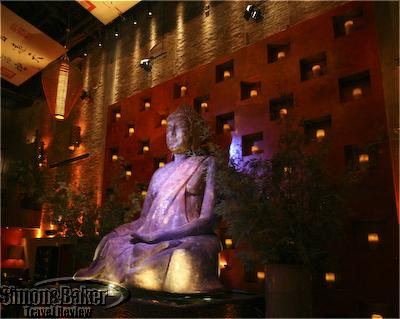
Tao buddha
Except for the near empty state of the large restaurant (we arrived in the late afternoon) it would have been hard to tell what time of day or night it was inside Tao Asian Bistro (3377 Las Vegas Blvd. South, Las Vegas, NV 89109, +1-702-388-8338, Taolasvegas.com). Such was the style of the nightclub and bistro which could accommodate 2,000 guests. Located at The Venetian Resort-Hotel-Casino, the two-story restaurant was crawling with shadows that made it appear mysterious. Done in a slightly different way it could have felt soulless but bright shades of red, brick walls, kanji characters reflected on the ceiling and larger than life decorative oriental artifacts lent it a certain magic. It had the air of a place that comes alive with patrons, especially in the evening.
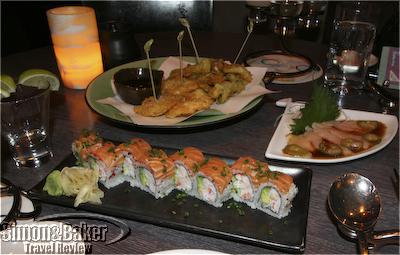
Tao appetizers
The hostess led us to the last booth, tucked away next to the kitchen door and across from a giant Buddha. Chris, our friendly and knowledgeable server, was with us moments later. At his suggestion, we tried two martinis: Tao-tini (Absolute Mandarin, Stoli Rasberry, Malibu Rum, cranberry and fresh lime juice) and a Lychee Martini (Ketel One, Triple and fresh luchee puree). For starters we shared the Yellowtail Sashimi with Jalapeño and Ponzu Sauce (a favorite); Alaskan Salmon, Crab and Avocado Roll; Kimchee and Baby Shanghai Bok Choy with Garlic.
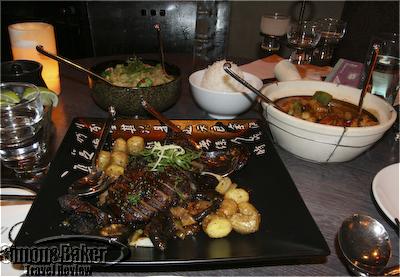
Wok Seared New York Sirloin with Shiitake Mushrooms and Szechwan Potatoes
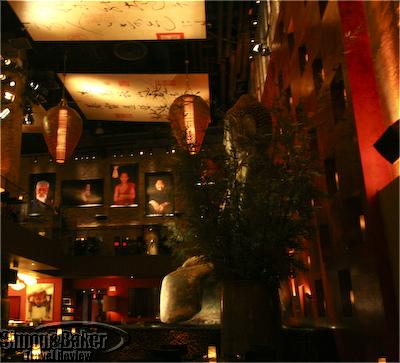
View of the Tao dining room from our seats
Then, our main courses arrived, a mountain of tasty food: Satay of Chilean Sea Bass with Wok Roasted Asparagus (a favorite); Lobster Wontons with Shiitake Ginger Broth; Sandpot Lobster, Shrimp and Scallops with Black Bean Sauce; Wok Seared New York Sirloin with Shiitake Mushrooms and Szechwan Potatoes; Jasmine White Rice, and Mandarin Sizzled Fried Rice with Duck. Chris recommended an ice cream dessert which we enjoyed. These culinary creations were the work of Mark Andelbradt, Tao’s executive chef, and Koji Noda, the executive sushi chef, and their staff.
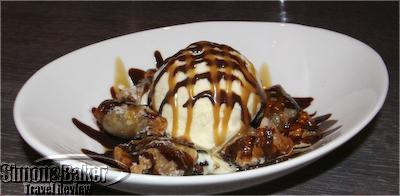
Our dessert
We washed it all down with six types of sake (Chris recommended this) including three “crazy fun” ones. He brought us the Spirit and Eternal selections from the sake by the glass menu. As we headed to our show (that’s why we arrived so early), the thought occured to me that although we sampled lots of savory dishes and drinks we would were pleasantly satisfied. We had a fun and enjoyable dinner at Tao.
by Editor | Mar 23, 2009 | Books, Products
By Chester Godsy
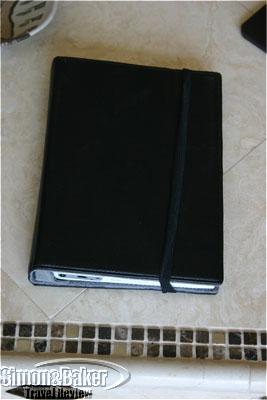
The Kindle closed
I have been very happy with my new Amazon Kindle. The readability of the screen is what really makes this device work. For the display it uses a type of opaque screen technology called E Ink. This display works very well in all types of lighting situations except for in the dark because it isn’t back lit. I would compare the screen very closely to the quality of a paperback book.
I finished reading several books on my Kindle. Soon after purchasing my first Kindle book we went on a long car trip across the country. During this trip I finished reading my first book. With no more books to read I then enabled the Kindle’s cell phone interface and began browsing the online Kindle book store (currently claiming over 240,000 titles) and found another book that I wanted to read. I purchased the book and it downloaded automatically to my Kindle as we were driving down the road. I was pretty happy to be able to get another book to read while riding down the highway in a car.
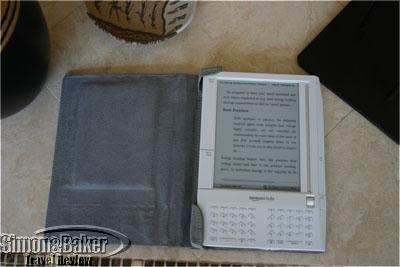
The Kindle open
Kindle book prices seem to always be lower than paperback versions; discounts vary anywhere from around a 25 percent to 75 percent over the paperback book versions. The Kindle uses a cellular phone network to download content from Amazon. The cellular phone interface is built into the Kindle and can be enabled or disabled with a switch located on the back of the device. As long as you use the built cell phone network to browse the Amazon store and download its content there is no extra charge for the cell phone connection time.
Another feature of the Kindle that I tried is the ability to convert document files into the Kindle book format. There are two methods of conversion available for Kindle users. One version requires payment to convert the document and then it automatically downloads to your Kindle. I used the free version to convert some technical papers into the Kindle format. With the free version it is necessary have to copy the converted files manually to your Kindle using a USB cable.
There are a couple of experimental features on the Kindle. One of them is the ability to play music. I downloaded mp3 files to my Kindle and tried this feature. It is a very primitive audio player. It just played the music I downloaded in a loop. I found this good if I want relaxing background music playing while I read. The other experimental feature is web browsing which I did not try because of the extra charges I would have incurred to access the web from my Kindle. Aside from the experimental features, after eight weeks I am pleased with the Kindle as a device to read books.
Click here to buy Kindle: Amazon’s Wireless Reading Device or
or
the new Kindle 2: Amazon’s New Wireless Reading Device (Latest Generation)
by Editor | Mar 16, 2009 | Accomodations, Audio, Ecotourism
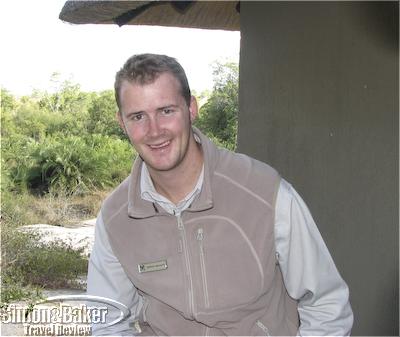
Duncan MacLarty, manager, Tree Camp
While in South Africa, one of our teams stayed at Tree Camp at Londolozi Private Game Reserve, an upscale bush property within the world famous Sabi Sand Reserve near http://simonandbaker.com/kruger. They enjoyed their visit and as a result we published a dedicated feature on Tree Camp and a newsletter article with video a few weeks ago. During their stay Elena del Valle had an opportunity to chat with Duncan MacLarty, the manager at Tree Camp about the property.
Click on the play button below to listen to their conversation.
by Editor | Mar 9, 2009 | Ecotourism, Luxury Travel, Products
Article and photos by Gary Cox
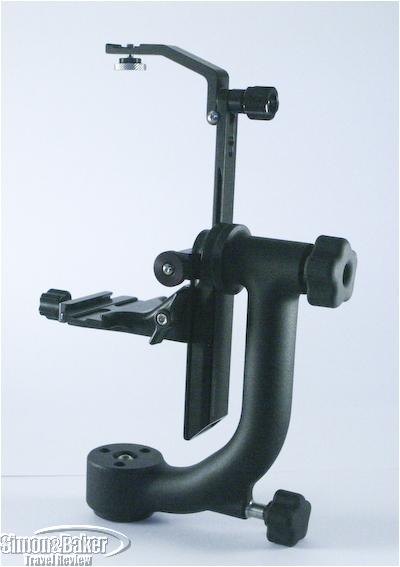
The Wimberley Head Version II
While on safari in South Africa last year, a ranger who was a fellow photographer, introduced me to the Wimberley Head. Mounted on a standard super clip, this piece of equipment revolutionized my game viewing photography. The super clip securely holds my 100-400 millimeter telephoto lens comfortably mounted onto the bars on the Land Rover or other game viewing vehicle. The telephoto lens is fitted with an Arca-Swiss style plate purchased separately from Wimberley.
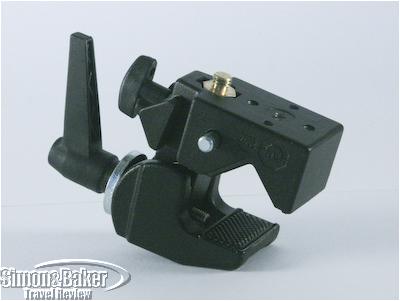
The Super Clip with Tripod Screw Head
The Wimberley tripod head uses a gimbal-type design to balance the camera and lens in all three dimensions. This greatly reduces the strain and potential shake of using it free hand, and the flexibility of movement is a big improvement over bean bag solutions I have tried. It is well engineered, with a solid feel, easy to use adjustments and clean lines. One notable issue, because it is mounted on the vehicle, other people moving around can cause the vehicle to shake, which can be quite annoying at the wrong moment. It is best suited for private to semi-private game drives because the camera extends over the seat in front of the photographer.
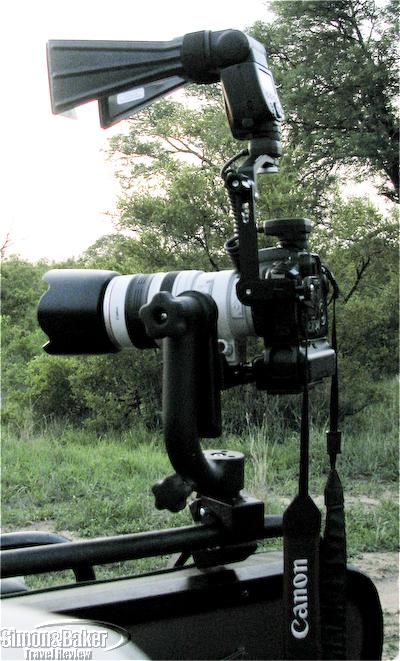
The full rig in the field
The photo above shows the full rig, including the external flash mount bar (sold separately). The flash extender completes the telephoto game viewing setup. This configuration, combined with the lens’ image stabilization, provides a great platform for wildlife photography, reducing the annoying windows of downtime in the early morning and late evening when some of the best viewings occur, but the light is too low for a telephoto shot. When the vehicle is moving from sighting to sighting, the flash unscrews from its mount with a thumb wheel and the clamp releases the plate on the camera to avoid shaking the equipment apart on the dirt roads.
The Wimberley Head travels with me whenever the telephoto lens is in the bag. It is now an indispensable element of my camera support equipment.
Wimberley, located in Winchester, Virginia is a small business owned by a father and son team, David and Clay Wimberley, both mechanical engineers dedicated to designing and making professional photography equipment. The company offers a 60-day unconditional money-back guarantee on all of its products and has loaners available through its Free Trial Program. For details visit Tripodhead.com
by Editor | Mar 2, 2009 | Restaurants and Food
Article and photos by Elena del Valle
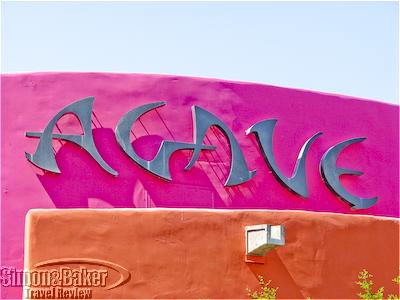
Agave Restaurant in Summerlin, Nevada
Agave Restaurant (10820 West Charleston Blvd., 702.214.3500, AgaveLasVegas.com) in Summerlin, a wealthy suburb of Las Vegas, was fun for a yummy Mexican style lunch and a sampling of fine tequilas. Located within a typical strip mall, it was hard for my transport service (I decided not to drive since we had planned a tequila tasting) to miss the bright facade. There was ample seating indoors and in the restaurant’s enclosed outdoor area. We sat indoors directly across from the pretty bar.
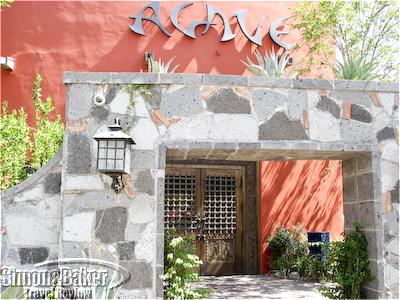
The entrance to Agave
Agave, named for the agave plant from which tequila is made, was decorated with iron and wood entrance doors, imperfect tile on the walls, and hand blown colored glass made by artisans from the Guadalajara region. It was colorful inside and out.

Inside Agave
We invited the chef, Antonio Mejia, to show off his favorite mild recipes and he sent enough food for a Guadalajara village: Freshly Made Guacamole with dungeness crab meat; Portabella Mushroom Tamal; Chile Braised Short Rib Taquitos; Spiced Chicken al Carbon Empanadas and my favorite, Shrimp and Crab Stacked Enchiladas.
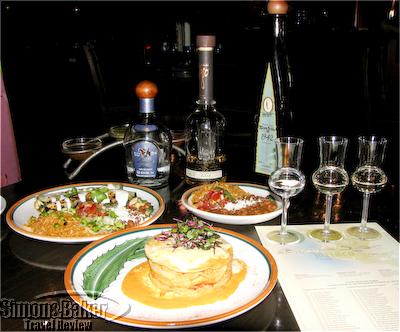
Lunch and tequila at Agave
The restaurant offers 89 different tequilas as part of its Tequila Flight Club. Although I pleaded tequila tasting ignorance right away, a patient bar tender shared insights on tequila making and history as well and suggestions on how to maximize the experience. It was best not to place my nose directly in the tequila glass to avoid the strong alcohol fumes. Instead, by using my hand to coax the tequila essence when I moved the glass I could gently appreciate the nuances of the individual tequilas, he explained.
We sampled one each from the Silver, Rested and Aged tequila options respectively: Tequila 7 Leguas, house Casa Noble, and Don Julio 1942. I tried not to look at the labels but, perhaps because I generally prefer smoky, smooth aged spirits, my favorite, hands down, was the Don Julio 1942.
The chef and bar manager, aficionados of the agave liquor, went to the city of Tequila, Mexico. While there they were the first people to ever purchase a barrel of tequila from Casa Noble, which according to the restaurant representative, is a very prestigious hacienda. The barrel was then bottled, numbered, and signed and now the restaurant sells it to its clientele – that was the house tequila we sampled.























